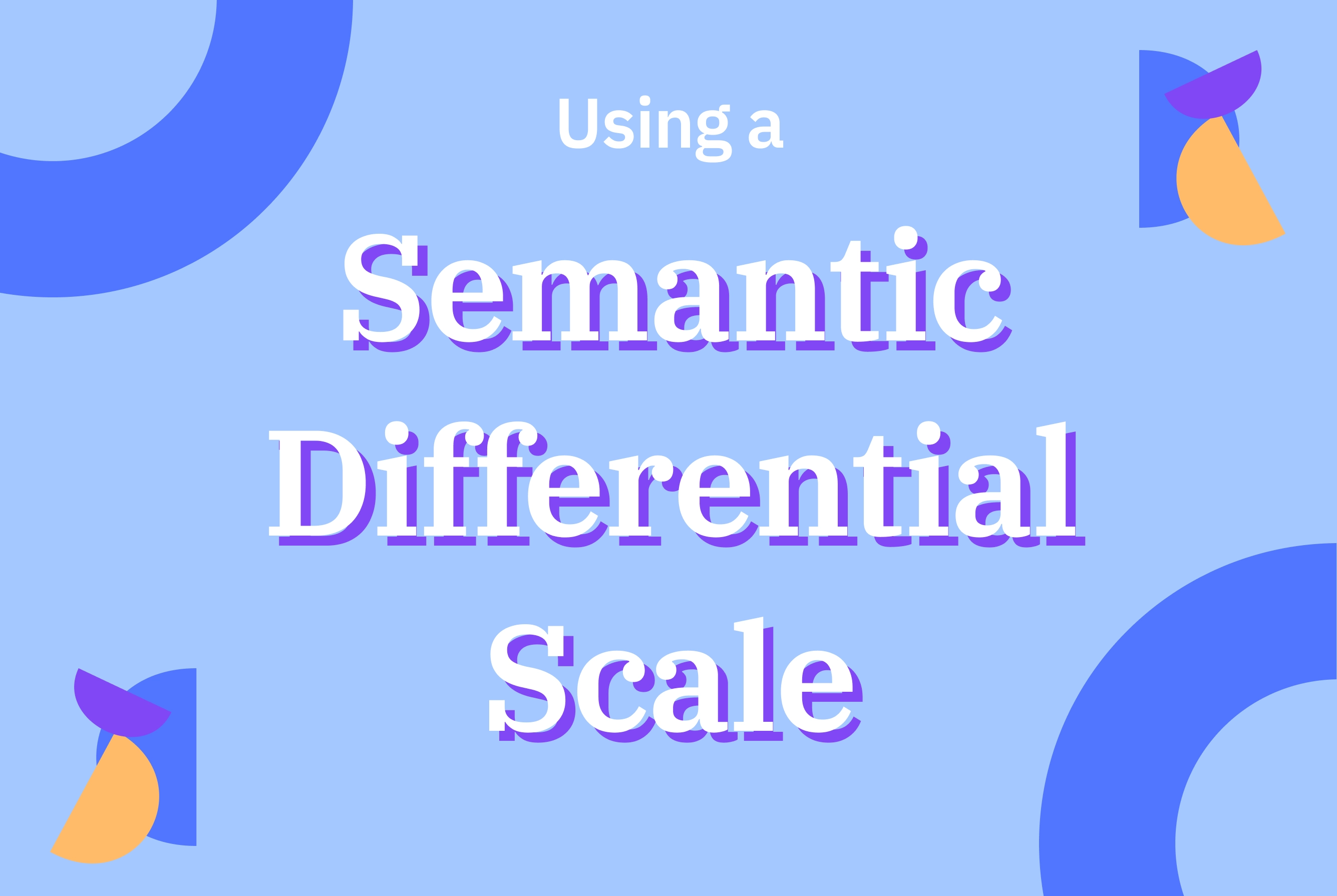Table content
Though launching a new product, service, or business can be an incredibly exciting undertaking, it’s also one of the most daunting. Any entrepreneur or community organizer can attest to the fact that they’ve stayed up at night wondering what people will think of their offering and if it matches with today’s consumer behavior and preferences.
But there are ways to understand what consumers are thinking that are far better than fretting and losing sleep – and embracing semantic differential scales is one of them.
What is a Semantic Differential Scale?
A unique survey tool, a semantic differential scale measures attitudes, perceptions, and opinions. This scale typically consists of a series of opposite adjectives that respondents evaluate on a continuum. For example, if asked to evaluate the taste of a new lime soda, respondents might be asked to rank the intensity of the flavor on a scale of sweet to sour.
By capturing nuanced feelings and thoughts, these insights can provide brands with a rich, multifaceted view of respondents’ attitudes toward a product, offering, or service.
Why Use a Semantic Differential Scale?
The primary purpose of a semantic differential scale is to quantify subjective experiences by gauging how individuals perceive various concepts, products, or ideas. This method is particularly effective because it captures the intensity of feelings, allowing researchers to gain a deeper understanding of consumer sentiment or behavioral tendencies. By analyzing the results, businesses can tailor strategies to better align with audience perceptions.
Consider a beauty company launching a new line of flavored lip balms. They might ask respondents to rate the product on a semantic differential scale using pairs like:
- User-friendly — Complicated
- Short-lived — Long-lasting
- Moisturizing — Drying
- Essential — Non-essential
Each pair allows respondents to position their perceptions along a spectrum, providing valuable insights into how the product is received.
Types of Semantic Differential Scales
There are several types of semantic differential scales that researchers and brands can use, including these four popular options:
- Bipolar Scales: Traditional scale with two opposing adjectives.
- Unipolar Scales: This scale is focused on a single adjective with a continuum (e.g., "satisfaction" ranging from "not satisfied" to "very satisfied").
- Five-Point Scales: These scales typically include options ranging from "very negative" to "very positive," providing a balanced view.
- Seven-Point Scales: Similar to a five-point scale, this option offers researchers a finer granularity, allowing for more detailed responses.
Semantic Differential Scale vs. Likert Scale
There are a multitude of scales that can be used to capture consumer attitudes, preferences, and impressions, including both the semantic differential scale and the Likert scale. While both scales measure attitudes, they serve different purposes.
The Likert scale typically asks respondents to express agreement or disagreement with a statement, usually on a five- or seven-point scale. In contrast, a semantic differential scale captures emotional responses to specific attributes, providing a more nuanced understanding of feelings associated with a concept.
How to Use a Semantic Differential Scale in Research
When planning to use a semantic differential scale in product, market, or consumer research, the usual workflow begins with pinpointing what you need to gather feedback and insights about, and requires careful consideration. The typical steps include:
- Defining the Concept: Clearly identify what is to be measured.
- Selecting Adjectives: Choose relevant bipolar adjectives that encapsulate the concept’s attributes.
- Determining the Scale: Decide on the type of semantic differential scale that best fits the research goals and business needs. (e.g., 5-point, 7-point).
- Collecting Data: Distribute the survey to the target audience.
- Analyzing Results: Interpret the data to derive insights into respondents’ perceptions.
Designing Effective Semantic Differential Scales
To gain useful and actionable insights when using a semantic differential scale, it’s critical that researchers carefully consider every element of the survey. LimeSurvey’s best practices for designing effective surveys includes examining the following:
- Relevance: Ensure the adjectives chosen are relevant to the concept being measured.
- Clarity: Provide respondents with clear instructions and use simple language throughout the survey to avoid confusion.
- Balance: Maintain an equal number of positive and negative adjectives to avoid bias.
- Length: When designing a scale that is more granular than the typical bipolar scale, stick with five or seven points to capture a range of emotions without overwhelming respondents.
Advantages and Disadvantages
When considering whether to use a semantic differential scale, it’s important to fully understand both the strengths and weaknesses of the format.
Advantages:
- Rich Data: Provides detailed insights into attitudes.
- Flexibility: Applicable across various fields, including marketing, psychology, and social research.
- Ease of Analysis: Data is straightforward to analyze statistically.
Disadvantages:
- Subjectivity: Responses can be influenced by individual interpretations of the adjectives.
- Complexity in Design: Requires careful selection of adjectives and scale format.
- Potential Bias: Some respondents may favor central options, skewing results.
By taking these points into consideration, researchers can work to ensure their survey is as strong as possible, to help produce robust insights.
Best Practices for Implementing a Semantic Differential Scale
To maximize the effectiveness of a semantic differential scale, teams and researchers should adopt the following best practices.
- Pilot Test: Conduct a small-scale test with a segment of your target audience to refine questions and ensure survey clarity.
- Educate Respondents: Provide easy-to-follow instructions on how to read the scale and complete the survey to minimize confusion.
- Balance Adjectives: Include a mix of positive and negative pairs to avoid bias.
- Analyze Context: Consider external factors that may influence responses during analysis.
With a semantic differential scale, businesses, organizations, and researchers have a powerful tool that can shed light on the perceptions and attitudes of today’s consumers, no matter the vertical, niche, or market. By following best practices in design and implementation, it’s possible to gain valuable insights that can not only impact decision-making, but strategy development and product innovation.
Whether you’re offering soda, lip balm, or a new community service, a semantic differential scale can reveal the complexities of human emotion and opinion, helping your organizations connect more deeply with their audiences.
With LimeSurvey, students, researchers, and enterprises can build, distribute, and analyze surveys using the open-source platform that is fully customizable to fit a wide array of needs.




